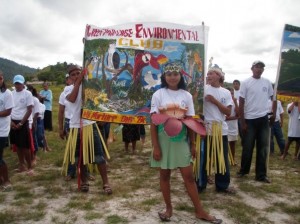 The 18 wildlife clubs of the North Rupununi are vibrant community-based youth clubs that provide members with an opportunity to gain firsthand experience in natural resource management, environmental stewardship and, of course, have fun.
The 18 wildlife clubs of the North Rupununi are vibrant community-based youth clubs that provide members with an opportunity to gain firsthand experience in natural resource management, environmental stewardship and, of course, have fun.
The idea for wildlife clubs in the North Rupununi originated when youth from the North Rupununi visited the Santa Rosa Wildlife Conservation Festival in Region One in 2009. Encouraged and enthused by what they saw and learnt from Murphy and Marco De Souza and the Santa Rosa Club, the North Rupununi youths formed the North Rupununi Junior Wildlife Development Council (NRJWDC) to coordinate between individual community clubs.
The main club objectives are developing an awareness and understanding of plants, animals, and physical characteristics of the forest; helping in local wildlife inventories and wildlife monitoring; understanding natural resource management and conservation, and building personal capacity and social skills.
There is a wildlife club in every community of the North Rupununi, and members are usually between 8 to 20 years old, with older members acting as chaperones and club coordinators. Many club activities include bird watching, rainfall monitoring, club exchanges and field trips, picnics, clean-up campaigns, art, poetry and sporting competitions.
 The clubs also promote environmental health in their communities, and many of these clubs take up local conservation and management projects as a result. Surama Junior Wildlife Club monitors birds and Giant River Otters- both species can tell us a lot about the health of the environment, and visitors to the community are always happy to see them. As a result, club members are directly involved in conservation and tourism as well as developing essential skills themselves.
The clubs also promote environmental health in their communities, and many of these clubs take up local conservation and management projects as a result. Surama Junior Wildlife Club monitors birds and Giant River Otters- both species can tell us a lot about the health of the environment, and visitors to the community are always happy to see them. As a result, club members are directly involved in conservation and tourism as well as developing essential skills themselves.
Club activities are planned during club meetings and provide opportunities for young people to learn management and administrative skills that can become useful later in life. Many clubs also take part in honing their public speaking skills as well as awareness about health and hygiene; after all, you can’t take care of the environment if you can’t take care of yourself!
Club activities combine traditional knowledge with scientific techniques and create a powerful tool for local management of natural resources in a fun and interactive manner. Club activities such as bird watching and monitoring have provided a strong foundation for many club members to become leaders in tourism and guiding in the area. Additionally, club activities help youths understand the environment as well as help build self-confidence, therefore setting the stage in developing leadership skills as well as understanding environmental issues such as climate change.
 As Guyana is at the fore in discussions about Reducing Emissions from Deforestation and Forest Degradation (REDD), many club members who have been involved and interested in their environment already understand basic concepts related to this issue. This is an essential knowledge base as Guyana is championing ground-breakingsteps with the Low Carbon Development Strategy.
As Guyana is at the fore in discussions about Reducing Emissions from Deforestation and Forest Degradation (REDD), many club members who have been involved and interested in their environment already understand basic concepts related to this issue. This is an essential knowledge base as Guyana is championing ground-breakingsteps with the Low Carbon Development Strategy.
The main event for wildlife clubs is the annual wildlife festival, a celebration of the environment and of Makushi culture. After attending the Santa Rosa Festival, clubs of the North Rupununi, assisted by Iwokrama, hosted their first wildlife festival in 2001 in Annai. Since then, this has become an annual event supported by the Iwokrama International Centre. Also, in keeping with the spirit of sharing, clubs from all over Guyana are invited to attend and take part in the celebrations.
These wildlife festivals provide an opportunity for club members to exchange ideas, talk about club activities, and to celebrate the North Rupununi’s rich wildlife and their own culture. The festivals are usually held the weekend before Easter holidays, and more than 250 youths showcase their costumes, banners, poetry, art music, skits and dances, all of which reflect the theme club members created in a February planning meeting.
Generally, all these activities are about animals, plants, forests, wetlands, and savannahs, but there are also discussions on social issues selected by the youths themselves. Past social issues have included HIV/AIDS, domestic violence, alcohol and drug abuse. Volunteers from organizations including the Guyana Red Cross, Help and Shelter and the Makushi Research Unit provide guidance and advice on these key social issues.
Organizations such as the Chicago Zoological Association, The National Audubon Society, Conservation International Guyana, the WWF Guianas and the EPA Guyana, have supported wildlife clubs over the years as it has become obvious that local interest in the environment leads to local management of resources. Last year marked the 10th anniversary of the Wildlife Festival of the North Rupununi.
Ten years after the formation of the wildlife clubs, many past club members have moved into areas of work that promote conservation, governance and social development in their communities, and we hope to see them and the clubs continue to flourish, ensuring that our wildlife stays intact and our environment stays healthy.